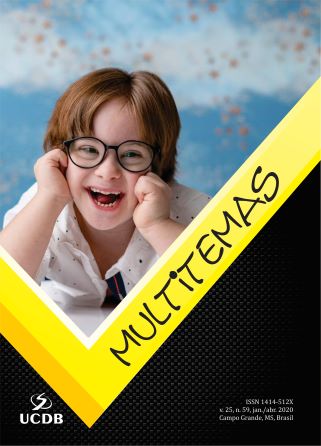Avaliação da mamada, autoeficácia do aleitamento materno e fatores influentes no desmame precoce em primíparas
DOI:
https://doi.org/10.20435/multi.v21i59.2831Keywords:
aleitamento materno, período pós-parto, mães.Abstract
O leite materno é o alimento mais recomendado para o bebê, porém as taxas de aleitamento materno no Brasil não atingiram níveis desejáveis. Objetivou-se avaliar a confiança das primíparas no aleitamento materno; identificar os parâmetros desfavoráveis à amamentação e correlacioná-los ao desmame precoce. Pesquisa prospectiva e observacional, composta por 101 primíparas avaliadas por meio da Escala de Autoeficácia da Amamentação (EAAM) e do Formulário de Observação da Mamada (FOM), no período pós-parto imediato e posterior, via contato telefônico, a fim de informar sobre a continuidade do aleitamento materno e/ou desmame. Elevados escores de EAAM foram encontrados, possivelmente, por conta do suporte da equipe que atua na promoção do aleitamento materno. A observação da mãe constituiu a variável preditiva para ocorrência do desfecho com desmame precoce. Comportamentos preditivos para o desmame precoce estão associados à condição física da mãe durante a mamada, sendo fundamental o monitoramento dos parâmetros desfavoráveis à amamentação, pela equipe.References
ALKOZEI, A.; MCMAHON, E.; LAHAV, A. Stress levels and depressive symptoms in NICU mothers in the early postpartum period. The Journal of Maternal-Fetal & Neonatal Medicine, v. 27, n 17, p. 1738-43, nov. 2014.
ALATALO, D.; JIANG, L.; GEDDES, D.; HASSANIPOUR, F. Capturing nipple deformation and peripheral pressure on the areola during breastfeeding. Journal Biomechanical Engineering, v. 142, n. 1, maio 2019. DOI: https://doi.org/10.1115/1.4043665
BRASIL. Ministério da Saúde (BR), Secretaria de Atenção à Saúde. Departamento de Atenção Básica. Saúde da criança: nutrição infantil: aleitamento materno e alimentação complementar. Brasília, DF, 2009.
DEGEFA, N.; TARIKU, B.; BANCHA, T.; AMANA, G.; HAJO, A.; KUSSE, Y.; ZERIHUN, E.; ASCHALEW, Z. Breast feeding practice: positioning and attachment during breast feeding among lactating mothers visiting health facility in Areka Town, Southern Ethiopia. International Journal of Pediatrics, v. 2019, ID 8969432, abr. 2019. DOI: https://doi.org/10.1155/2019/8969432
DURAN S.; KAYNAK, S.; KARADAS, A. The relationship between breastfeeding attitudes and perceived stress levels of Turkish mothers. Scandinavian Journal of Caring Sciences, 2019.
FALLON, V.; GROVES, R.; HALFORD, J. C.; BENNETT, K. M.; HARROLD, J. A. Postpartum anxiety and infant-feeding outcomes. Journal of Human Lactation, v. 32, n. 4, p. 740-58, nov. 2016. DOI: https://doi.org/10.1177/0890334416662241
FLAHERMAN, J. V.; MCKEAN, M.; BRAUNREUTHER, E.; KAIR, L. R.; CABANA, M. D. Minimizing the relationship between early formula use and breastfeeding cessation by limiting formula volume. Breastfeeding Medicine, v. 14, n. 8, p. 533-37, out. 2019. DOI: https://doi.org/10.1089/bfm.2019.0055
GEDDES, D. T.; CHOOI, K.; NANCARROW, K.; HEPWORTH, A. R.; GARDNER, H.; SIMMER, K. Characterisation of sucking dynamics of breastfeeding preterm infants: a cross sectional study. BMC Pregnancy and Childbirth, v. 17, n. 1, p. 386, nov. 2017. DOI: https://doi.org/10.1186/s12884-017-1574-3
GIANNI, M. L. et al. Breastfeeding difficulties and risk for early breastfeeding cessation. Nutrients, v. 11, n. 10, PII: E2266, set. 2019. DOI: https://doi.org/10.3390/nu11102266
GIGANTE, D. P.; VICTORA, C. G.; BARROS, F. C. Nutrição materna e duração da amamentação em uma coorte de nascimento de Pelotas, RS. Revista de Saúde Pública, São Paulo, v. 34, n. 3, p. 259-65, 2000.
INGRAM, J.; JOHNSON, D.; GREENWOOD, R. Breastfeeding in Bristol: teaching good positioning, and support from fathers and families. Midwifery, v. 18, n. 2, p. 87-10, jun.2002.
ISLAM, M. J.; BAIRD, K.; MAZEROLLE, P.; BROIDY, L. Exploring the influence of psychological factors on exclusive breastfeeding in Bangladesh. Archives of Women’s Mental Health, v. 20, n. 1, p. 173-88, fev. 2017. DOI: https://doi.org/10.1007/s00737-016-0692-7
KAMIYA, E.; MENDONÇA, L. A. B. M.; FERREIRA, R. S., PALHARES, D. B. Prevalência de aleitamento materno em Campo Grande, Mato Grosso do Sul, Brasil. Multitemas, Campo Grande, MS, v.24, 57, p. 257-72, maio/ago. 2019.
MATTHEY, S.; FISHER, J.; ROWE, H. Using the Edinburgh postnatal depression scale to screen for anxiety disorders: conceptual and methodological considerations. Journal of Affective Disorders, v. 146, n. 2, p. 224-30, abr. 2013. DOI: https://doi.org/10.1016/j.jad.2012.09.009
ORIA, M. O.; XIMENES, L. B.; DE ALMEIDA, P. C.; GLICK, D. F.; DENNIS, C.‐L. Psychometric assessment of the Brazilian version of the Breastfeeding Self-Efficacy Scale. Public Health Nursing. v. 26, n. 6, p. 574-83, nov./dez. 2009. DOI: https://doi.org/10.1111/j.1525-1446.2009.00817.x
SILVA, H. A.; PASSOS, M. H. P.; OLIVEIRA, V. M. A.; PALMEIRA, A. C.; PITANGUI, A. C. R.; ARAÚJO, R. C. Short version of the Depression Anxiety Stress Scale-21: is it valid for Brazilian adolescents? Einstein (São Paulo), v. 14, n. 4, p. 486-93, out./dez. 2016. DOI: https://doi.org/10.1590/s1679-45082016ao3732
VILLAR, J. et al. International standards for newborn weight, length, and head circumference by gestational age and sex: the Newborn Cross-Sectional Study of the INTERGROWTH-21st Project. The Lancet, v. 384, n. 9946, p. 857-68, set. 2014. DOI: https://doi.org/10.1016/S0140-6736(14)60932-6
WENZEL, D.; SOUZA, S. B. Prevalência do aleitamento materno no Brasil segundo condições socioeconômicas e demográficas. Journal of Human Growth and Development, v. 21, n. 2, p. 251-8, 2011. DOI: https://doi.org/10.7322/jhgd.20013.
WILLIAMSON, I.; LEEMING, D.; LYTTLE, S.; JOHNSON, S. ‘It should be the most natural thing in the world’: exploring first-time mothers’ breastfeeding difficulties in the UK using audio-diaries and interviews. Maternal & Child Nutrition, v. 8, n. 4, p. 434-47, out. 2012.
Downloads
Published
How to Cite
Issue
Section
License
Os artigos publicados na Revista Multitemas têm acesso aberto (Open Access) sob a licença Creative Commons Attribution, que permite uso, distribuição e reprodução em qualquer meio, sem restrições desde que o trabalho original seja corretamente citado.
Direitos Autorais para artigos publicados nesta revista são do autor, com direitos de primeira publicação para a revista. Em virtude de aparecerem nesta revista de acesso público, os artigos são de uso gratuito, com atribuições próprias, em aplicações educacionais e não-comerciais.


